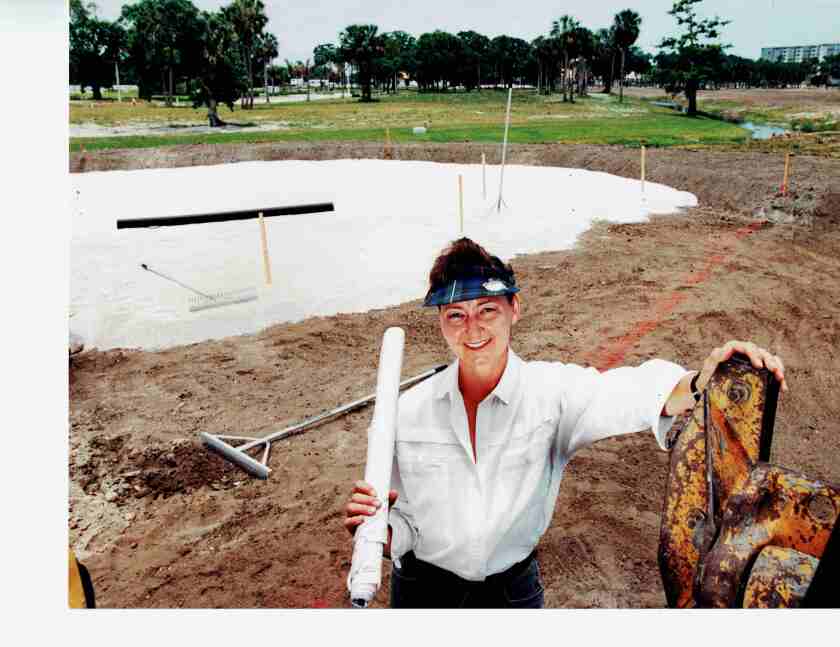It’s hard for Jan Bel Jan and Cynthia Dye McGarey not to stand out in the “team photo” taken each year for the American Society of Golf Course Architects despite all the designers fitted in identical red plaid Donald Ross tartan blazers.
Bel Jan and McGarey are the only two females in the esteemed group. The passing of Alice Dye, who was the first female elected to the ASGCA in 1984, and Vicki Martz has cut the female roll call to just two of out 170 members.
And it’s unlikely few, if any, female architects are in the pipeline.
The already narrow field has gotten even tighter over the past decade with fewer new golf courses being designed in the United States, leaving even less opportunity for females to break into the business here or abroad.
The European Institute of Golf Course Architects lists three women — Kari Haug, who owns the Minneapolis-based Kari Haug Planning and Design; Giulia Ferroni, director of Leeds Golf Design Architects and Consultants in England; and Virginia Costa, who is an associate, along with Emma Han, Fry Straka Global Golf Design. A simple Google search for "golf course architects" produces a list featuring 2002 names, of which only five are women.
“There aren’t that many job opportunities, it’s a small field, it’s specialized,” said McGarey, whose uncle was the late Hall of Famer Pete Dye. “I had a gal who worked for me and she played golf all through college. She went to St. Andrews to their golf architecture school and when she came back I gave her a job, but she just wanted to go out and play golf, so she is now a club pro. It’s a lot of travel, and now it’s a lot of computer work, and I don’t think a lot of people like sitting in front of a computer all the time.”
Bel Jan, a former president of the ASGCA and owner of a Florida-based course design firm with her name, said the job also requires intense toiling on site.
“Twenty-five years ago I was working on a project and there was an LPGA player who was thinking about a next career because she was done playing and asked me if she could come with me on site. I said, ‘sure but bring your boots, what I am doing today requires walking,”’ Bel Jan said. “So she met me and it was in the afternoon in South Florida and it was 90 degrees with 70 percent humidity, and we’re walking in soft sugar sand. After that half day it wasn’t as glamorous. It doesn’t matter what the weather is that day the job still needs to be done.”
The four women who have been voted into the ASGCA since 1984 have made a major impact in the business, working for some of the best in the history of golf course architecture — Dye, Tom Fazio and Arnold Palmer.

Martz, who was interviewed shortly before passing away in 2017, said as a female architect you are always “the odd one in the room. But there was so much respect given to me throughout the industry.”
“When I told Ed Seay (Arnold Palmer’s longtime partner) what I wanted to do he told me it wasn’t just hard work but that I was going to have to get an iron bra,” Martz recalled. “He said ‘When you go out there these bulldozer operators are tough birds, and you have to be able to stand up to them and they are not going to want to take direction from a woman.’ Well, I found it exactly the opposite. I think women have a sense of cooperation, so it was always my goal to get out there and respect the history and the art form of molding the land. I was always inclusive and brought the guys in the trenches into the ideas of what they thought.”
Still, even in 2021, the male ego is a factor.
"It's a macho thing, no doubt," said Seay during a 2004 Sports Illustrated feature on the subject of female course architects. "I'd like to see this change, but it's going to take time. This part of golf has always been a man's game."
“When Tom (Fazio) saw that I was capable, then that’s all Tom ever wanted — people who were interested and had passion and who had a willingness to learn,” added Bel Jan. “I met the criteria of all those things. There was no reason not to permit me to do field work just because I was a female.”
American Marion Hollins and Great Britain’s Molly Gourlay are considered the most prominent early women course architects, arriving on the scene during the first third of the 20th century. Though fabled architect Alister MacKenzie is credited for designing the scenic Cypress Point Club in Monterey, Calif., Hollins reportedly was an influential voice. She apparently coaxed MacKenzie into building the par-3 16 after proving a carry off the tee was achievable.
During the golf architecture boom many of the game’s most renowned male figures — Palmer, Jack Nicklaus, Gary Player and Tom Watson — formed golf course design firms. Tiger Woods has now followed suit. Most of their female counterparts didn’t though.
Jan Stephenson, Nancy Lopez and Annika Sorenstam are three of the more prominent former players who have dabbled in course design, but there are not many. McGarey, who works for the family-owned Dye Designs, has a theory.
“A lot of these (great) female golfers that do (golf course architecture) a little bit they also still play golf, and to make a business out of golf course architecture and play golf at the same time, is well, really impossible,” she said. “To make any money out of it you have to be full time. Their focus has to be so intense when they’re playing golf, and after they get done with golf they may want a family because they have traveled playing golf their whole life. Golf course architecture just doesn’t necessarily interest them.”
Bel Jan concurred.
“It’s like with black golfers,” she said. “If you don’t see others doing it then you are probably less interested. Can you remember a time when 99.9 percent of nurses were female? Can you observe now there are more male nurses than you’ve ever seen before? And it’s the same thing with flight attendants. But both of those are high-profile jobs seen by a broad range of people unlike a golf course architect.”












